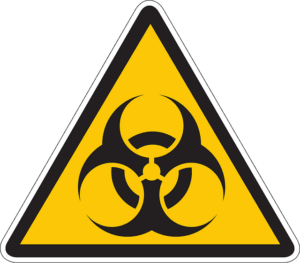The Basics of Biohazard Cleanup
One of our most important services is biohazard cleanup. Biohazards often are present in other types of situations, such as crime scene or unattended death cleanup. They’re not uncommon when we come in to deal with a home that’s been occupied by a hoarder. More than just a messy job, biohazard cleanup can be a dangerous process if not done properly. To understand why, it may be helpful to get a grasp on what a biohazard is.

Universal symbol for biohazard
What Is a Biohazard?
‘Biohazard’ is short for biological hazard. Simply put, a biohazard is a biological substance (plant, animal, virus, bacteria or other living or once-living substance) that presents a health threat. The most common types are bodily fluids – blood, feces, saliva, urine, vomit. All these fluids might carry a toxic or health-threatening substance.
Now, you might wonder how these could be toxic. After all, a parent deals with these fluids on a daily basis without a problem. Yes, every time a mom or dad changes a dirty diaper, they’re confronting a biohazard. But unless the child is infected with HIV or hepatitis or another dangerous bacteria or virus, the threat is minimal or nonexistent. But you’re probably aware that in hospitals and other public settings human waste is handled and disposed of very carefully because of potential health threats.
Here are some examples of common biohazards:
- Medical waste
- Human or animal bodily fluids (blood, saliva, semen, cerebrospinal fluids, vaginal fluids, and even amniotic fluid
- Pathological waste (lab testing materials, biopsy samples, dissected tissue)
- Human and animal waste (everything from decomposing body to excretory waste)
- Medical ‘sharps’ – needles and sharp implements, including discarded drug needles
- Bacteria, fungi, and viruses – including mold (especially black mold)
- Parasites
There is some disagreement in the industry as to whether common ordinary mold (other than black mold) should be considered a biohazard, but as it is often accompanied by another type of biohazard such decomposing substances, we elect to handle it as if it is toxic and dangerous. In fact, for those who have mold sensitivities or allergies, it IS a health threat.
Biohazards don’t all pose the same level of threat to human health or safety or to the environment. The Centers for Disease Control (CDC) classifies biohazards in four levels:
- Level 1: Minimal threat. The e. coli bacteria is an example of a Level 1 biohazard. You might get some unpleasant gastrointestinal side effects but rarely is it a life-threatening situation. Most molds are Level 1. Biohazards of these types can usually be handled without professional assistance.
- Level 2: Can cause severe illness. Level 2 biohazards include salmonella, HIV and hepatitis, as well as some molds. Level 1 and Level 2 require direct contact.
- Level 3: If airborne, can cause a major health threat if inhaled. Level 3 pathogens include tuberculosis. This level is more dangerous than Level 1 or 2 substances because direct contact is not required – airborne substances can be inhaled without the victim having knowledge of their existence.
- Level 4: Substances pose a severe threat to health. Usually there is no known treatment or antidote for these substances, which include the Ebola virus.
When biohazards are present, proper steps must be taken to safely remove them, clean up the area, and properly dispose of the substance as well as remediating any threats. Our cleanup crews are trained in the safe and proper methods to remove and dispose of biohazards, particularly the ones which pose severe threats to health and safety, such as Level 2, Level 3 or Level 4. And our staff is professional and discreet. You can count on us to restore your property to a safe condition when biohazards are present.



